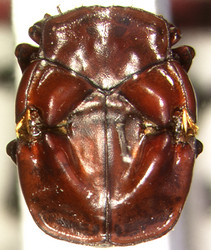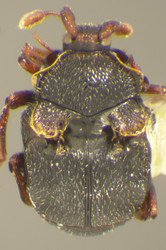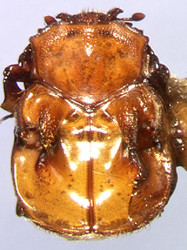Chlamydopsis
Michael S. Caterino


This tree diagram shows the relationships between several groups of organisms.
The root of the current tree connects the organisms featured in this tree to their containing group and the rest of the Tree of Life. The basal branching point in the tree represents the ancestor of the other groups in the tree. This ancestor diversified over time into several descendent subgroups, which are represented as internal nodes and terminal taxa to the right.

You can click on the root to travel down the Tree of Life all the way to the root of all Life, and you can click on the names of descendent subgroups to travel up the Tree of Life all the way to individual species.
For more information on ToL tree formatting, please see Interpreting the Tree or Classification. To learn more about phylogenetic trees, please visit our Phylogenetic Biology pages.
close boxIntroduction
Chlamydopsis, with around 70 known species, is the largest genus in the subfamily Chlamydopsinae. Because a significant part of this diversity occurs in the more temperate parts of Australia, near the early population centers, it is also one of the best known. About a third of its species were described in early papers by Arthur Lea and Charles Oke. The morphological diversity within this genus is astounding, and once phylogenetic relationships are better known it may be desireable to split it into multiple genera. Caterino (2003) described the bulk of the known species, and established informal species groups to hold similar, and presumably related species.
Much of what we know about the biology of Chlamydopsinae comes from observations of species of Chlamydopsis. The early Australian naturalists generally found these beetles in situ with their host ants, publishing many host records and interesting biological observations. Species of Chlamydopsis cover a broad range of host ants, living in the colonies of Formicinae, Myrmicinae, Dolichoderinae, and especially Ponerinae (Caterino, 2003). In the last of these subfamilies, one species, Rhytidoponera metallica (Smith) hosts more known Chlamydopsis than any other ant.
Characteristics
Species of Chlamydopsis are difficult to define as a group. All species have some kind of trichome on the front corner of each elytron, and a few have additional trichomes on the sides of the pronotum. In contrast to a large number of genera in the subfamily, the scutellum in species of Chlamydopsis is fully exposed, though this is obviously a plesiomorphic character. Most species have the pronotum at least margined laterally, and in most species it is clearly elevated, on both the sides and the front, making the pronotum appear depressed. Essentially all species have strongly dimorphic antennal clubs, with that of the male appearing very elongate, usually longer than all the other segments (including the large scape) combined.
The most closely related genera, Eucurtia and Ectatommiphila, are each separated from Chlamydopsis by their own unique autapomorphies, and they are not easily separated otherwise. It remains possible that Chlamydopsis is paraphyletic with respect to these.
References
Caterino, M. S. 2003. New species of Chlamydopsis, with a review and phylogenetic analysis of all known species. Memoirs of the Queensland Museum 49:159–235.
Information on the Internet
- Color images of all species. Supplement to descriptive paper, hosted by M. Caterino and the Santa Barbara Museum of Natural History.
Title Illustrations

| Scientific Name | Chlamydopsis matthewsi |
|---|---|
| Specimen Condition | Dead Specimen |
| Identified By | Michael S. Caterino |
| Collection | South Australian Museum, Adelaide |
| Type | Holotype |
| Image Use |
 This media file is licensed under the Creative Commons Attribution-ShareAlike License - Version 3.0. This media file is licensed under the Creative Commons Attribution-ShareAlike License - Version 3.0.
|
| Copyright |
©

|
| Scientific Name | Chlamydopsis caledoniae |
|---|---|
| Specimen Condition | Dead Specimen |
| Identified By | Michael S. Caterino |
| Collection | Museum National de Histoire Naturelle, Paris |
| Type | Holotype |
| Image Use |
 This media file is licensed under the Creative Commons Attribution-ShareAlike License - Version 3.0. This media file is licensed under the Creative Commons Attribution-ShareAlike License - Version 3.0.
|
| Copyright |
©

|
| Scientific Name | Chlamydopsis storeyi |
|---|---|
| Specimen Condition | Dead Specimen |
| Identified By | Michael S. Caterino |
| Collection | The Queensland Museum, Brisbane |
| Type | Holotype |
| Image Use |
 This media file is licensed under the Creative Commons Attribution-ShareAlike License - Version 3.0. This media file is licensed under the Creative Commons Attribution-ShareAlike License - Version 3.0.
|
| Copyright |
©

|
About This Page

Santa Barbara Museum of Natural History, Santa Barbara, California, USA
Correspondence regarding this page should be directed to Michael S. Caterino at
Page copyright © 2007
 Page: Tree of Life
Chlamydopsis .
Authored by
Michael S. Caterino.
The TEXT of this page is licensed under the
Creative Commons Attribution License - Version 3.0. Note that images and other media
featured on this page are each governed by their own license, and they may or may not be available
for reuse. Click on an image or a media link to access the media data window, which provides the
relevant licensing information. For the general terms and conditions of ToL material reuse and
redistribution, please see the Tree of Life Copyright
Policies.
Page: Tree of Life
Chlamydopsis .
Authored by
Michael S. Caterino.
The TEXT of this page is licensed under the
Creative Commons Attribution License - Version 3.0. Note that images and other media
featured on this page are each governed by their own license, and they may or may not be available
for reuse. Click on an image or a media link to access the media data window, which provides the
relevant licensing information. For the general terms and conditions of ToL material reuse and
redistribution, please see the Tree of Life Copyright
Policies.
- First online 15 July 2007
- Content changed 15 July 2007
Citing this page:
Caterino, Michael S. 2007. Chlamydopsis . Version 15 July 2007 (under construction). http://tolweb.org/Chlamydopsis/9259/2007.07.15 in The Tree of Life Web Project, http://tolweb.org/











 Go to quick links
Go to quick search
Go to navigation for this section of the ToL site
Go to detailed links for the ToL site
Go to quick links
Go to quick search
Go to navigation for this section of the ToL site
Go to detailed links for the ToL site